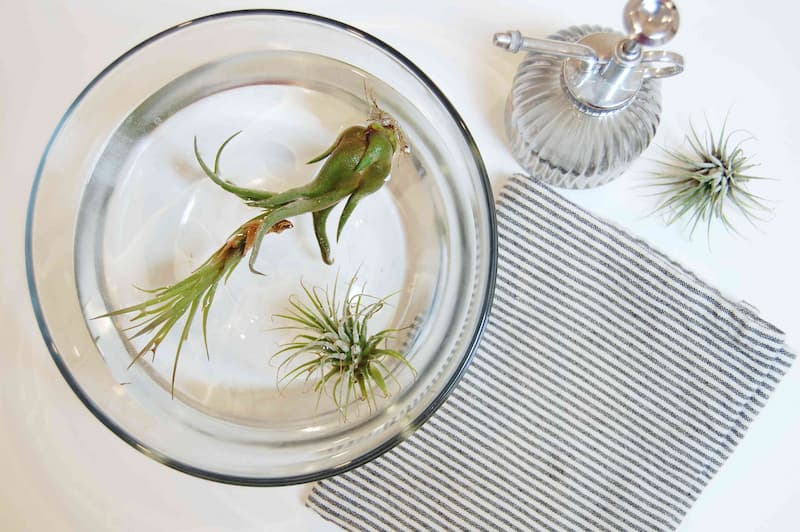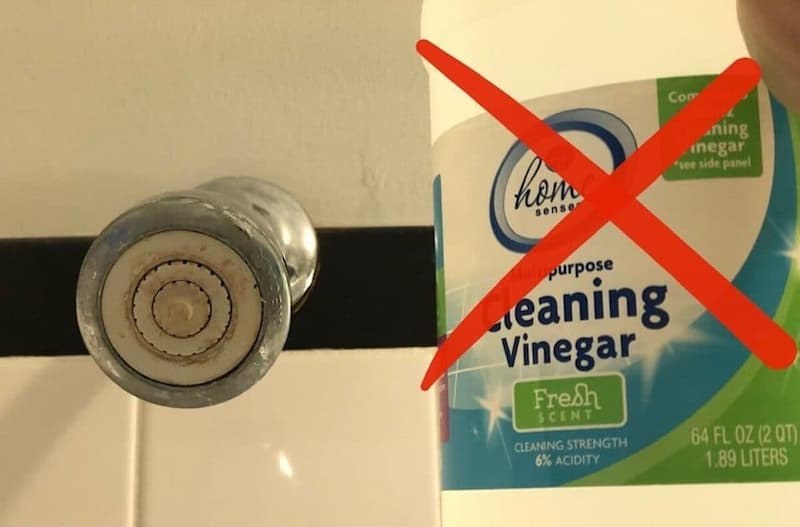First, how to water air plant?
Soak your air plants in a bowl of water for 20 minutes to an hour every week to 10 days is best. Submerge the entire plant. Although they naturally get wet all the time in nature, if your plant is in bloom, you may want to keep the bud above the water to avoid disturbing it.
The air plants known as tillandsia are so much fun. They are totally different from other plants in that they don’t need soil to survive. However, in order to thrive, they do need a different watering schedule. To properly water air plants and keep them hydrated and content all year long, follow these instructions.
For more specific information, keep reading.
Table of Contents
Perfect Time To Water Air Plants
Water your air plants early in the day so they have time to dry out during the day. Depending on the type of air plant you have, their growing environment, and other factors, you should water your air plants at different intervals. The frequency of watering may be less frequent for the plants if they are growing in a consistently humid environment than if they are.
However, when grown in typical household conditions, the majority of air plants only need to be watered once every one to two weeks. For information on how frequently to water your particular type of air plant, be sure to do some research on it.
Required Tools
- Spray bottle or mister
- Bowl, cup, or vase
- Towel
- Filtered or distilled water
By Soaking: Water Air Plants
This technique works well for watering most types of air plants.
- Prepare a Vessel
Warm, distilled or filtered water should be placed in a tiny bowl, cup, or vase. - Submerge the Plant
Place your air plant in the water, covering the majority of the leaves, and let it soak for 20 to 40 minutes. - Shake and Air Dry
The plant should be shaken to remove any remaining water from the leaves after it has finished soaking. Then, hang the plant upside-down on a towel for 10 to 15 minutes to let it drip-dry before putting it back where it usually grows. This will assist in avoiding any remaining water from collecting on the leaves and leading to rot.
By Misting: Water Air Plants
Certain air plants such as the Tillandsia tectorum should be watered by misting rather than soaking or dunking due to its extra fuzzy trichomes. This technique can also be used to water other fuzzy air plant varieties.
- Prepare the Water and Plant
Filtered or distilled water that is lukewarm should be put into a spray bottle or mister. Remove your air plant before watering if it is residing in a glass terrarium or other enclosed area. Stem rot might result from too much moisture being trapped in the terrarium. - Mist Thoroughly
Thoroughly mist your air plant until the leaves are damp but not dripping. Before putting it back in its original place, let it dry.
By Dunking: Water Air Plants
Air plants with curled leaves such as the Tillandsia xerographica prefer to be watered with a quick dunk rather than a long soak. Additionally, compared to some of its smaller relatives, this particular Tillandsia variety doesn’t require as much watering. The maximum frequency should be once every two to three weeks.
- Prepare the Water
Warm filtered or distilled water should be placed in a bowl, cup, or vase. - Dunk Quickly
Make sure the plant is completely submerged in the water before submerging it, and take it out of the water right away. - Shake and Dry Upside-Down
Shake off any extra water from the plant’s leaves, then place them upside-down on a towel to dry for ten to fifteen minutes before putting them back where they belong.

How Often To Water Air Plants?
“How often you water your Tillandsia depends on the humidity; and whether you have a xeric variety from an arid region, or a mesic variety from a humid climate,” says At Mountain Crest Gardens, a nursery that specializes in succulents and air plants, Annie Schreck is the director of botanical research. In comparison to mesic varieties, xeric air plants might need less frequent soaking. “We generally advise soaking your air plant for an hour once a week as a starting point, says Schreck.
In addition to watering on a regular schedule, you can determine if your air plant needs water by closely inspecting the leaves. As the plant consumes moisture, the edges of each leaf will curl inward along its length. A thirsty air plant will also feel limp as a whole, though it won’t wilt as visibly as other plants do. See more about Air Plant Bloom
The Best Water For Air Plants
Rainwater is ideal for air plants, but pond or aquarium water will also work because they all contain some nutrients. It’s acceptable to use regular tap water as long as it first sits in an open container for an entire night. “As a result, chlorine can dissipate and the water can warm up, according to Steil. Leaf tips turn brown when there is too much chlorine present. Softened or distilled water should not be used, according to Steil. “According to him, distilled water is too “pure” and won’t give the air plants any of the nutrients they require because the salts in softened water can harm the leaves.
Through their leaves, air plants take up nutrients in addition to water. “Usually, they get nutrients from rain water that drips down through trees, so it’s important to feed domesticated Tillandsia with an air-plant-specific fertilizer,” says According to the label’s instructions, add some fertilizer to the soaking water once a month. Alternately, spray your air plants once a month with a pre-mixed air plant fertilizer ($7; Etsy) after giving them a soak.
Watering Air Plants With Flowers
Another watering challenge arises from flowering air plants. “While in bloom, the majority of air plants will require more frequent watering; just make sure that the water doesn’t collect in the center of the plant, where it could lead to rot,” advises Steil. The blooming period will be reduced by wetting the flower. The best way to water a flower is to keep the leaves submerged but not the flower itself. “If that’s too challenging, frequently mist the leaves while avoiding wetting the flower. As long as you take care to only wet the leaves and not the flowers, you can also hold the air plants under gently running water, advises Steil. See more about Hanging Air Plant
Adhering To Wood Or Other Support: Water Air Plants
On occasion, air plants are glued to decorative support. Although they can thrive in this environment, it can be a little awkward to water the plant. If at all possible, soak the air plant without submerging the wood or other object to which it is attached. After that, be sure to invert the plant so that it can completely dry. Alternately, according to Schreck, “passing just the plant under running water 2 to 4 times a week, or misting it thoroughly 3 to 7 times a week.” See more about How To Make An Air Plant Terrarium
An Unhappy Air Plant Signs
If your air plant is displaying symptoms of distress, overwatering may be to blame. A sign of under-watering could be browning, crispy tips. Additionally, you’ll see that without water, the concave shape of the air plant is more obvious.
Overwatering symptoms, however, are challenging to reverse. The air plant has rotted if it is losing leaves quickly and the base has turned black or brown. Hold your nose and hope you don’t need to water!
Tips For Watering Your Air Plants
Additional advice for watering air plants is provided below:
- Use filtered, spring, or well water that has undergone thorough cleaning. Water from ponds or aquariums also works well because the added nutrients are good for the plants. Avoid tap water that has been artificially softened or that contains a lot of chlorine or chloramine.
- Avoid using RO or distilled water as the plant will eventually suffer from the lack of nutrients. Water trace minerals and nutrients are beneficial to air plants. If you must use these types of water, it is suggested that you add some nutrients back by using a small amount of fertilizer. It’ll be welcomed by the plants!
- If you’re using tap water, let it stand outside for a while to let the chlorine evaporate. Many municipalities now use chloramine instead of chlorine. Chloramine needs to be filtered out because it won’t disappear on its own.
- Since Tillandsia use a process called CAM to breathe at night, it is best to water early in the day or in the morning. Dry conditions will make CAM respiration easier.
- After watering, give your air plants a gentle shake to remove any extra water, especially if they are xerographica species.
- Keep in mind how your plants appear after a thorough soak; this is how a Tillandsia will look when it is properly hydrated. After that, you can keep an eye on how it appears and eventually determine when they need more water. Wrinkles on the leaves and leaves that curl inward on themselves are common indicators of dehydration in the majority of species.
- Your watering routine may need to change as the seasons change, especially in the winter and summer. Depending on your climate, you might need to water less during the winter. However, you might need to mist your plants in between waterings if they are close to a heater. Due to the heat and increased light during the summer, your air plants may require more water, so be sure to keep an eye on them!
Conclusion
Making sure your plants receive enough water is one of the most crucial steps in keeping them happy and healthy. Many people mistakenly believe that because these tiny creatures are known as “air plants,” they can survive without water. Sorry guys, they aren’t that low maintenance. They still require water to survive and develop! Depending on the type of plant you have and where you live in the country, there are a few different ways to water it.













